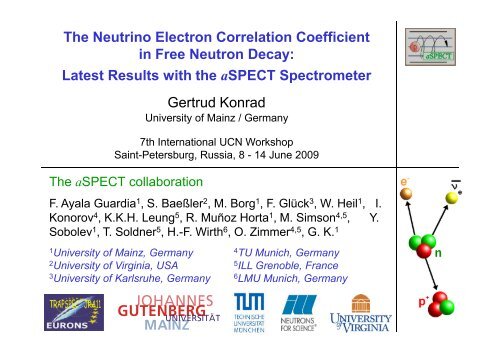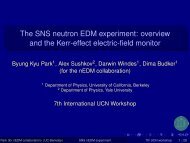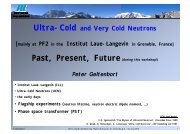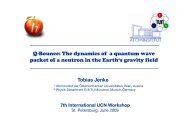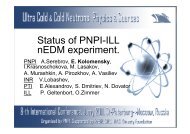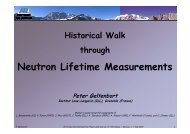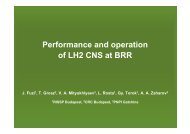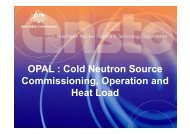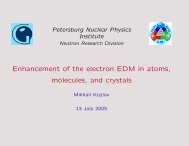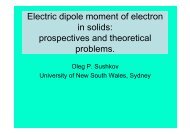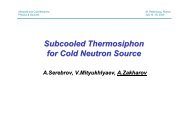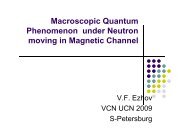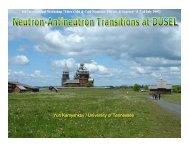The Neutrino Electron Correlation Coefficient in Free Neutron Decay ...
The Neutrino Electron Correlation Coefficient in Free Neutron Decay ...
The Neutrino Electron Correlation Coefficient in Free Neutron Decay ...
You also want an ePaper? Increase the reach of your titles
YUMPU automatically turns print PDFs into web optimized ePapers that Google loves.
<strong>The</strong> <strong>Neutr<strong>in</strong>o</strong> <strong>Electron</strong> <strong>Correlation</strong> <strong>Coefficient</strong><br />
<strong>in</strong> <strong>Free</strong> <strong>Neutron</strong> <strong>Decay</strong>:<br />
Latest Results with the aSPECT Spectrometer<br />
Gertrud Konrad<br />
University of Ma<strong>in</strong>z / Germany<br />
7th International UCN Workshop<br />
Sa<strong>in</strong>t-Petersburg, Russia, 8 - 14 June 2009<br />
<strong>The</strong> aSPECT collaboration<br />
F. Ayala Guardia 1 , S. Baeßler 2 , M. Borg 1 , F. Glück 3 , W. Heil 1 , I.<br />
Konorov 4 , K.K.H. Leung 5 , R. Muñoz Horta 1 , M. Simson 4,5 , Y.<br />
Sobolev 1 , T. Soldner 5 , H.-F. Wirth 6 , O. Zimmer 4,5 , G. K. 1<br />
1<br />
University of Ma<strong>in</strong>z, Germany 4<br />
TU Munich, Germany<br />
2<br />
University of Virg<strong>in</strong>ia, USA 5<br />
ILL Grenoble, France<br />
3<br />
University of Karlsruhe, Germany 6<br />
LMU Munich, Germany
Outl<strong>in</strong>e<br />
• <strong>The</strong> Ant<strong>in</strong>eutr<strong>in</strong>o-electron angular correlation<br />
coefficient a <strong>in</strong> free neutron decay<br />
• <strong>The</strong> <strong>Neutron</strong> decay spectrometer aSPECT<br />
• Prelim<strong>in</strong>ary results from the beam time at ILL,<br />
Grenoble (Spr<strong>in</strong>g 2008)<br />
• Improvements and Outlook<br />
• Summary<br />
G. Konrad, University of Ma<strong>in</strong>z <strong>The</strong> aSPECT Experiment, 7th Int’l UCN Workshop Sa<strong>in</strong>t -Petersburg 11 June 2009
<strong>Neutron</strong> <strong>Decay</strong> Parameters (SM)<br />
H G V n γ γ γ p ν γ γ γ e<br />
5<br />
weak F ud e μ μ 5<br />
<br />
<br />
<br />
p + e -<br />
n<br />
n<br />
Jackson et al., PR 106, 517 (1957)<br />
dW<br />
<br />
2 2<br />
2 p e e<br />
e e<br />
ud<br />
1 3 1 a p <br />
m p p p p<br />
GFV<br />
b<br />
n<br />
EE A e<br />
Ee<br />
E B <br />
e<br />
E D <br />
<br />
<br />
<br />
<br />
<br />
<br />
<br />
<br />
EE<br />
e <br />
<br />
ν e<br />
<br />
<strong>Neutron</strong> lifetime<br />
<br />
1<br />
G 2<br />
n<br />
V F ud<br />
<br />
2 1 3 <br />
2<br />
<br />
<strong>Neutr<strong>in</strong>o</strong>-<strong>Electron</strong> <strong>Correlation</strong><br />
2<br />
1<br />
<br />
a <br />
2<br />
1 3<br />
Beta-Asymmetry<br />
2<br />
cos<br />
A 2<br />
2<br />
1<br />
3<br />
Coupl<strong>in</strong>g constant ratio<br />
<br />
g<br />
g<br />
A<br />
V<br />
e<br />
i<br />
, where phase = 180° (with<strong>in</strong> the SM)<br />
λ can be extracted from measurements of either a, A or B<br />
over-determ<strong>in</strong>ed process<br />
G. Konrad, University of Ma<strong>in</strong>z <strong>The</strong> aSPECT Experiment, 7th Int’l UCN Workshop Sa<strong>in</strong>t -Petersburg 11 June 2009
Possible Tests of the Standard Model<br />
• Search for Right-handed Currents<br />
‣ W R ?<br />
• Search for Scalar and Tensor Interactions<br />
‣ Leptoquarks? Charged Higgs Bosons?<br />
• Search for Supersymmetric Particles<br />
‣ (Loop corrections to Beta <strong>Decay</strong> change Coupl<strong>in</strong>g Constants)<br />
• Test of the Unitarity of the Cabibbo-Kobayashi-Maskawa-Matrix<br />
d'<br />
Vud<br />
Vus<br />
Vub<br />
d<br />
<br />
s' V V V s<br />
cd cs cb<br />
b ' Vtd Vtd V <br />
tb<br />
b<br />
<br />
V<br />
ud<br />
2<br />
<br />
<br />
4908.7 1.9<br />
<br />
n<br />
<br />
2<br />
1<br />
3<br />
2 2 2<br />
V V V 1<br />
ud<br />
us ub<br />
<br />
<br />
Kaon decays<br />
s<br />
B/ D mesons<br />
G. Konrad, University of Ma<strong>in</strong>z <strong>The</strong> aSPECT Experiment, 7th Int’l UCN Workshop Sa<strong>in</strong>t -Petersburg 11 June 2009
Search for Scalar and Tensor Interactions<br />
Left-handed Scalar and Tensor Model:<br />
(Time reversal <strong>in</strong>variance)<br />
g g g g g g<br />
1, 1, , and <br />
g g g g g g<br />
'<br />
'<br />
'<br />
'<br />
V A S S<br />
T T<br />
V A V V A A<br />
P.A. Vetter et al., Phys. Rev. C 77,<br />
035502 (2008)<br />
Right-handed Scalar and Tensor Model:<br />
(Time reversal <strong>in</strong>variance and b = 0)<br />
g g g g g g<br />
1, 1, , and <br />
g g g g g g<br />
'<br />
'<br />
'<br />
'<br />
V A S S<br />
T T<br />
V A V V A A<br />
g T<br />
/g A<br />
0.3<br />
0.2<br />
95% CL<br />
90% CL<br />
68.27% CL<br />
g T<br />
/g A<br />
0.3<br />
0.2<br />
95% CL<br />
90% CL<br />
68.27% CL<br />
g T<br />
/g A<br />
0.3<br />
0.2<br />
95% CL<br />
90% CL<br />
68.27% CL<br />
0.1<br />
0.1<br />
0.1<br />
0.0<br />
0.0<br />
0.0<br />
-0.1<br />
-0.1<br />
-0.1<br />
-0.2<br />
-0.3<br />
a PDG = -0.103(4)<br />
A PDG = -0.1173(13), B PDG = 0.9807(30)<br />
-0.2<br />
-0.3<br />
a PDG = -0.1030(3)<br />
A PDG = -0.1173(13), B PDG = 0.9807(30)<br />
-0.2<br />
-0.3<br />
a PDG = -0.1048(3)<br />
A PDG = -0.1173(13), B PDG = 0.9807(30)<br />
-0.3 -0.2 -0.1 0.0 0.1 0.2 0.3<br />
-0.3 -0.2 -0.1 0.0 0.1 0.2 0.3<br />
-0.3 -0.2 -0.1 0.0 0.1 0.2 0.3<br />
g S<br />
/g V<br />
g S<br />
/g V<br />
g S<br />
/g V
Determ<strong>in</strong>ation of A V<br />
g<br />
g<br />
λ from neu utron beta decay<br />
-1.250 Measurements of A<br />
Measurements of a<br />
-1.255<br />
-1.260<br />
-1.265<br />
-1.270<br />
-1.275<br />
-1.280<br />
λ=-1.2695(29) from PDG2008<br />
• PERKEO II is the<br />
systematically cleanest<br />
experiment<br />
• Still the disagreement with<br />
older measurements is not<br />
expla<strong>in</strong>ed<br />
• A measurement of a is<br />
<strong>in</strong>dependent of possible<br />
unknown errors <strong>in</strong> A;<br />
systematics are entirely<br />
different<br />
Present best experiments<br />
have Δa/ a ~ 5 %<br />
Aim of aSPECT<br />
is Δa/ a ~ 0.3% <br />
G. Konrad, University of Ma<strong>in</strong>z <strong>The</strong> aSPECT Experiment, 7th Int’l UCN Workshop Sa<strong>in</strong>t -Petersburg 11 June 2009
<strong>The</strong> <strong>Neutr<strong>in</strong>o</strong>-<strong>Electron</strong> <strong>Correlation</strong> a<br />
and the Proton Spectrum <strong>in</strong> <strong>Neutron</strong> <strong>Decay</strong><br />
<strong>The</strong> <strong>Correlation</strong> coefficient a<br />
dW<br />
v e<br />
<br />
<br />
1 a cos p , p<br />
<br />
<br />
n<br />
<br />
e <br />
c<br />
<br />
<br />
<br />
e - e -<br />
<br />
p + e -<br />
Sensitivity of the Proton Spectrum to a<br />
θ<br />
ν e<br />
n<br />
ν e<br />
n<br />
p +<br />
<strong>Decay</strong> rate w p(T) p<br />
p +<br />
Proton k<strong>in</strong>etic<br />
energy is big<br />
ν e<br />
Proton k<strong>in</strong>etic<br />
energy is small<br />
Proton spectrum for a = + 0.3<br />
and for a = - 0.103(4) (PDG 2008)<br />
0 200 400 600<br />
Proton k<strong>in</strong>etic energy T [eV]<br />
G. Konrad, University of Ma<strong>in</strong>z <strong>The</strong> aSPECT Experiment, 7th Int’l UCN Workshop Sa<strong>in</strong>t -Petersburg 11 June 2009
Setup of aSPECT at PF1b/ ILL<br />
and Spectrometer sketch<br />
Proton detector<br />
Proton<br />
Detector<br />
-15kV<br />
Magnetic<br />
Field<br />
Analyz<strong>in</strong>g Plane<br />
Electrode<br />
U A<br />
E B<br />
(0V to<br />
+800V)<br />
Analyz<strong>in</strong>g<br />
Plane<br />
Protons<br />
<strong>Neutron</strong> decay<br />
<br />
<br />
<strong>Decay</strong><br />
Volume<br />
Anti-magnetic screen<br />
+1kV<br />
Electrostatic<br />
Mirror<br />
<strong>Neutron</strong><br />
Beam<br />
G. Konrad, University of Ma<strong>in</strong>z <strong>The</strong> aSPECT Experiment, 7th Int’l UCN Workshop Sa<strong>in</strong>t -Petersburg 11 June 2009
Pr<strong>in</strong>ciple of a Retardation spectrometer<br />
p ||<br />
p ||<br />
p <br />
Adiabatic<br />
conversion<br />
p <br />
Analyz<strong>in</strong>g plane<br />
Potential barrier<br />
eU B A = 0.44 T<br />
Magnetic field<br />
Proton trajectory<br />
B 0 = 2.2 T<br />
<strong>Decay</strong> volume<br />
<strong>Decay</strong> rate w p (T)<br />
Proton spectrum for a = + 0.3<br />
and for a = - 0.103(4) (PDG 2008)<br />
Transmission function @ U A = 375V<br />
0 200 400 600<br />
Proton k<strong>in</strong>etic energy T [eV]<br />
1.0<br />
0.8<br />
0.6<br />
0.4<br />
0.2<br />
0.0<br />
Transm mission function F tr (T;U A )<br />
Transmission function F tr (T;U A ) <strong>in</strong> the adiabatic limit<br />
<br />
0 ; T eU<br />
A<br />
<br />
Ftr<br />
T; UA1 1B0<br />
BA<br />
1 eUA<br />
E<br />
; otherwise<br />
<br />
<br />
1 ; T eU<br />
A 1B<br />
B<br />
A 0<br />
<br />
G. Konrad, University of Ma<strong>in</strong>z <strong>The</strong> aSPECT Experiment, 7th Int’l UCN Workshop Sa<strong>in</strong>t -Petersburg 11 June 2009
Pr<strong>in</strong>ciple of extraction of a<br />
and Statistical sensitivity<br />
Pulse height spectrum<br />
U A<br />
Total proton count rate [s -1 ]<br />
500<br />
400<br />
300<br />
200<br />
Integrated Proton Spectrum<br />
Simulation for a = + 0.3<br />
and for a = - 0.103(4) (PDG 2008)<br />
Experimental data (offset subtracted)<br />
0<br />
0 100 200 300 400 500 600 700<br />
• About 470 events per second at U A = 50 V (on one detector pad)<br />
• Statistical sensitivity to a about 2 % per 24 hours measurement time<br />
100<br />
U<br />
; U <br />
N<br />
A<br />
Ft<br />
r<br />
T<br />
A<br />
wp<br />
T dT<br />
Analyz<strong>in</strong>g plane voltage U A [V]<br />
M. Simson et al., Proceed<strong>in</strong>gs of the IWPPSN, Nucl. Instr. and Meth. A, accepted, arXiv:0811.3851<br />
G. Konrad et al., Proceed<strong>in</strong>gs of the PANIC08, submitted to Nucl. Phys. A
Systematic effects I: Trap Clean<strong>in</strong>g<br />
<br />
<strong>Decay</strong> protons can be shifted with an E Belectrode, that<br />
removes charged particles stored between AP and Mirror<br />
<br />
E B<br />
vd<br />
<br />
2<br />
B<br />
Background measured @ U A = 780V<br />
<br />
for two different sett<strong>in</strong>gs of the E B electrode<br />
780V<br />
Analyz<strong>in</strong>g<br />
Plane<br />
<strong>Neutron</strong><br />
beam off<br />
<strong>Neutron</strong><br />
beam on<br />
<strong>Neutron</strong><br />
beam off<br />
U 1<br />
U 2<br />
+1kV<br />
Electrostatic<br />
Mirror<br />
G. Konrad, University of Ma<strong>in</strong>z <strong>The</strong> aSPECT <strong>The</strong> aSPECT Experiment, Experiment, 7th Int’l DPG UCN Spr<strong>in</strong>g Workshop Meet<strong>in</strong>g Sa<strong>in</strong>t Munich -Petersburg 09<br />
11 June 2009
Systematic effects II: Edge effect<br />
Detector<br />
Detector<br />
B <br />
B <br />
<strong>Neutron</strong> beam<br />
<strong>in</strong>tensity<br />
<strong>Decay</strong> volume<br />
Intensity<br />
<strong>Decay</strong> volume<br />
Projected area<br />
• Protons produced outside the directly<br />
projected volume can hit the detector<br />
• and protons produced with<strong>in</strong> the<br />
projected area might miss the detector<br />
This two effects cancel if the beam<br />
profile is flat, <strong>in</strong>dependent of the proton<br />
gyration radius<br />
G. Konrad, University of Ma<strong>in</strong>z <strong>The</strong> aSPECT Experiment, 7th Int’l UCN Workshop Sa<strong>in</strong>t -Petersburg 11 June 2009
Systematic effects II: Edge effect<br />
Detector<br />
Detector<br />
B <br />
B <br />
<strong>Neutron</strong> beam<br />
<strong>in</strong>tensity<br />
<strong>Decay</strong> volume<br />
Intensity<br />
<strong>Decay</strong> volume<br />
Transition region<br />
… But if the profile is non-flat the<br />
probabilities for the two cases become<br />
different, and dependent on the proton<br />
gyration radius<br />
<strong>The</strong> gyration radius depends on the<br />
<strong>in</strong>itial angle and energy of the proton<br />
<strong>The</strong> beam profile has to be<br />
sufficiently flat or well known<br />
G. Konrad, University of Ma<strong>in</strong>z <strong>The</strong> aSPECT Experiment, 7th Int’l UCN Workshop Sa<strong>in</strong>t -Petersburg 11 June 2009
Systematic effects II: Edge effect<br />
<strong>Neutron</strong> beam<br />
<strong>in</strong>tensity<br />
normalized to maximum<br />
1.0<br />
0.8<br />
06 0.6<br />
0.4<br />
0.2<br />
0.0<br />
<strong>Neutron</strong> beam profile<br />
at the exit flange of the spectrometer<br />
for two different apertures<br />
Full neutron beam profile<br />
Profile with additional aperture<br />
-40 -20 0 20 40<br />
Projected<br />
area<br />
Width y [mm]<br />
Uncorrected neu utr<strong>in</strong>o electron<br />
correlation coe efficient a exp<br />
<strong>The</strong> <strong>Correlation</strong> coefficient a<br />
-0.08<br />
-0.10<br />
-0.12<br />
a=-0.103(4) from PDG2008<br />
Full beam<br />
Narrow<br />
beam<br />
Each data po<strong>in</strong>t corresponds to about<br />
14 hours of measurement time<br />
… Monte Carlo simulations<br />
are currectly on the way<br />
G. Konrad, University of Ma<strong>in</strong>z <strong>The</strong> aSPECT Experiment, 7th Int’l UCN Workshop Sa<strong>in</strong>t -Petersburg 11 June 2009
Systematic effects III: <strong>The</strong> Magnetic field ratio<br />
External Helmholtz coils<br />
allow us to change magnetic<br />
field ratio r B B<br />
B<br />
For 0 A: r B = 0.2030; For 50 A: r B ‘= 0.2049<br />
<br />
0 ; T eU<br />
A<br />
<br />
Ftr<br />
T; UA1 1B0<br />
BA<br />
1 eUA<br />
E<br />
; otherwise<br />
<br />
<br />
1 ; T eU<br />
A 1B<br />
A<br />
0<br />
B<br />
A 0<br />
<br />
Uncorrected neutr<strong>in</strong>o electron<br />
correlation coefficient a exp<br />
-0.08<br />
-0.10<br />
-0.12<br />
Helmholtz<br />
coils off<br />
a=-0.103(4) from PDG2008<br />
F tr (T) with<br />
r B = 0.2030<br />
Helmholtz<br />
coils on<br />
F tr (T) with<br />
r B = 0.2030<br />
Helmholtz<br />
coils on<br />
F tr (T) with<br />
r B ‘ = 0.2049<br />
<strong>Correlation</strong> coefficient a exp<br />
changes with the magnetic<br />
field ratio r B , as described<br />
by a slightly different<br />
transmission function<br />
F tr (T;U A )<br />
Each data po<strong>in</strong>t corresponds to about<br />
14 hours of measurement time<br />
G. Konrad, University of Ma<strong>in</strong>z <strong>The</strong> aSPECT Experiment, 7th Int’l UCN Workshop Sa<strong>in</strong>t -Petersburg 11 June 2009
Improvements and Outlook<br />
… But a Δa/ a ~ 0.3% measurement requires<br />
U<br />
10mV<br />
4<br />
B<br />
B <br />
<br />
10<br />
• Electric potential measurements: accurate voltage measurement with<br />
multimeter, but: Surface charges<br />
<br />
<br />
<br />
A<br />
0<br />
<strong>Decay</strong> Volume<br />
Analyz<strong>in</strong>g Plane<br />
‣ Investigations of the work function of the electrodes (Kelv<strong>in</strong> probe)<br />
• Onl<strong>in</strong>e monitor<strong>in</strong>g of the magnetic field ratio<br />
‣ NMR system with polarized 3 He<br />
• Calibration source<br />
U A<br />
G. Konrad, University of Ma<strong>in</strong>z <strong>The</strong> aSPECT Experiment, 7th Int’l UCN Workshop Sa<strong>in</strong>t -Petersburg 11 June 2009
Onl<strong>in</strong>e monitor<strong>in</strong>g of the magnetic field ratio<br />
Analyz<strong>in</strong>g Plane<br />
Electrode<br />
Capacitors<br />
Amplitude V<br />
0.2<br />
0.1<br />
ν = γ He-3 B 0<br />
γ He-3 ≈ 32.436 [MHz/T]<br />
NMR coil<br />
0.0<br />
-0.1<br />
T 2 ≈ 6 ms<br />
-0.2<br />
0 2 4 6 8 10<br />
Copper tube<br />
for He-3 fill<strong>in</strong>g<br />
Amplitude<br />
0.004004<br />
0.003<br />
FFT transformation<br />
Time ms<br />
0.002<br />
0.001<br />
Electrode<br />
systeme<br />
0.000<br />
0 10000 20000 30000 40000 50000<br />
• Proof of pr<strong>in</strong>ciple<br />
• Accuracy better than 10 -4<br />
r B B<br />
Frequency Hz<br />
• Magnetic field ratio stable <strong>in</strong> time<br />
B<br />
A<br />
0<br />
G. Konrad, University of Ma<strong>in</strong>z <strong>The</strong> aSPECT Experiment, 7th Int’l UCN Workshop Sa<strong>in</strong>t -Petersburg 11 June 2009
Summary<br />
• aSPECT extracts a from the measured <strong>in</strong>tegrated proton spectrum<br />
<strong>in</strong> free neutron decay<br />
• Statistical accuracy about 2 % per 24 hours measurement time<br />
• Studied several systematic effects<br />
• Total accuracy expected to be well below the present literature<br />
value of 5 %<br />
• Data analysis is currently on the way<br />
• A statistical accuracy of Δa/ a ~ 0.3% can be obta<strong>in</strong>ed with<strong>in</strong> one<br />
further beam time at ILL<br />
G. Konrad, University of Ma<strong>in</strong>z <strong>The</strong> aSPECT Experiment, 7th Int’l UCN Workshop Sa<strong>in</strong>t -Petersburg 11 June 2009
Backup<br />
G. Konrad, University of Ma<strong>in</strong>z <strong>The</strong> aSPECT Experiment, 7th Int’l UCN Workshop Sa<strong>in</strong>t -Petersburg 11 June 2009
Why <strong>in</strong>vestigate <strong>Neutron</strong> Beta <strong>Decay</strong>?<br />
A decay<strong>in</strong>g neutron is an easy system.<br />
p = (udu)<br />
u<br />
e -<br />
32<br />
Cl (17p+15n)<br />
d e +<br />
e -<br />
μ<br />
d<br />
n = (ddu)<br />
W ±<br />
e<br />
W ±<br />
u<br />
32<br />
Ar (18p+14n)<br />
e<br />
μ -<br />
W ±<br />
e<br />
neutron (β - ) decay<br />
32<br />
Ar (β + ) decay muon decay<br />
Universality: If we neglect phase space, nuclear structure,<br />
and sp<strong>in</strong> states, all decays are equal<br />
G. Konrad, University of Ma<strong>in</strong>z <strong>The</strong> aSPECT Experiment, 7th Int’l UCN Workshop Sa<strong>in</strong>t -Petersburg 11 June 2009
Coupl<strong>in</strong>g Constants of the Weak Interaction<br />
Coupl<strong>in</strong>g Constants <strong>in</strong> <strong>Neutron</strong> <strong>Decay</strong><br />
p = (udu)<br />
u<br />
g V , g A<br />
W ± e - ν e<br />
p<br />
Primordial Nucleosynthesis<br />
W ± e -<br />
p<br />
W ± e +<br />
ν e<br />
d<br />
n = (ddu)<br />
n<br />
ν e<br />
n + ν e ↔ p + e -<br />
n<br />
n + e + ↔ p + ν e<br />
n → p + e - + ν e<br />
Solar cycle<br />
Start of Big Bang Nucleosynthesis,<br />
Primordial 4 He abundance<br />
<strong>Neutr<strong>in</strong>o</strong> Detection (SNO, CC)<br />
2<br />
H +<br />
2<br />
H +<br />
ν e<br />
p + p<br />
e -<br />
e + ν e<br />
W ±<br />
W ±<br />
p + p<br />
p + p<br />
W ± e -<br />
p + p → 2 H + + e + + ν e p + e - + p → 2 H + + ν e<br />
Start of Solar Cycle, determ<strong>in</strong>es amount of<br />
Solar <strong>Neutr<strong>in</strong>o</strong>s<br />
G. Konrad, University of Ma<strong>in</strong>z <strong>The</strong> aSPECT Experiment, 7th Int’l UCN Workshop Sa<strong>in</strong>t -Petersburg 11 June 2009<br />
2<br />
H +<br />
ν e<br />
ν e + 2 H + → p + p + e -<br />
Efficiency of <strong>Neutr<strong>in</strong>o</strong> Detectors
<strong>The</strong> Beta <strong>Decay</strong> Hamiltonian<br />
Task:<br />
Construction of Parity-Violat<strong>in</strong>g Hamiltonian,<br />
which couples leptons and hadrons<br />
60<br />
Co<br />
I I e -<br />
≠<br />
60<br />
Co<br />
e -<br />
5 '<br />
H<br />
weak,elementary<br />
GF<br />
u γ <br />
<br />
γ γ d e γμ<br />
γμγ5<br />
ν<br />
<br />
V<br />
<br />
A<br />
Properties: Helicity of (relativistic) fermions is -1, of antifermions is 1<br />
e<br />
Complication: Nucleons aren‘t elementary particles:<br />
H G V p γ γ γ n e γ γγ ν<br />
5 <br />
weak F ud μ μ 5 e<br />
Coupl<strong>in</strong>g constants are unknown. Fermi-Transitions: g V = G F·V ud<br />
Gamow-Teller-Transitions:<br />
g A = G F·V ud·λ<br />
G. Konrad, University of Ma<strong>in</strong>z <strong>The</strong> aSPECT Experiment, 7th Int’l UCN Workshop Sa<strong>in</strong>t -Petersburg 11 June 2009
<strong>Neutron</strong> Lifetime Measurements<br />
Decrease of <strong>Neutron</strong> Counts N with storage time t: N(t) = N(0)exp{-t/τ eff }<br />
1/ τ eff = 1/τ β +1/ τ wall losses<br />
Spivak 88<br />
<strong>Neutron</strong> lifetime [s]<br />
895<br />
Nesvizhevsky 92<br />
Byrne 96<br />
890<br />
Mampe 89<br />
885<br />
Arzumanov 00<br />
Mampe 93<br />
880<br />
Dewey 03<br />
PDG2006<br />
MAMBO<br />
Serebrov 05<br />
875<br />
1988 1992 1996 2000 2004<br />
Year of Publication<br />
Many new attempts planned, mostly with magnetic bottles<br />
G. Konrad, University of Ma<strong>in</strong>z <strong>The</strong> aSPECT Experiment, 7th Int’l UCN Workshop Sa<strong>in</strong>t -Petersburg 11 June 2009
<strong>The</strong> Unitarity of the CKM Matrix<br />
Cabibbo-Kobayashi-Maskawa-Matrix<br />
d'<br />
Vud<br />
Vus<br />
Vub<br />
d<br />
<br />
s' V V V s<br />
cd cs cb<br />
b ' Vtd<br />
Vtd<br />
V <br />
tb<br />
b<br />
<br />
V<br />
Unitarity Condition<br />
ud<br />
2<br />
<br />
V<br />
us<br />
2<br />
<br />
V<br />
ub<br />
2<br />
1<br />
• B/D mesons<br />
• Superallowed Fermi <strong>Decay</strong>s<br />
• <strong>Neutron</strong> <strong>Decay</strong><br />
n → p + e - + ν e<br />
• Pion <strong>Decay</strong><br />
• Kaon (Ke3) <strong>Decay</strong>s<br />
K → e + π + ν e<br />
• Kaon (Kμ2) <strong>Decay</strong>s<br />
K → μ + ν μ<br />
• Hyperons<br />
G. Konrad, University of Ma<strong>in</strong>z <strong>The</strong> aSPECT Experiment, 7th Int’l UCN Workshop Sa<strong>in</strong>t -Petersburg 11 June 2009
Primordial Nucleosynthesis<br />
Before Phase Transition:<br />
Equilibrium<br />
p<br />
W ± e -<br />
p<br />
ν e<br />
p<br />
W ± e -<br />
After Phase Transition (about 1 m<strong>in</strong> after Big Bang):<br />
n<br />
ν e<br />
W ± e +<br />
n + ν e ↔ p + e - n + e + ↔ p + ν e<br />
n + p → d + γ d + d → 3 He + n → t + p d + 3 He → 4 He + p<br />
<strong>The</strong>n the Primordial Nucleosynthesis stops, s<strong>in</strong>ce there are no stable nuclei<br />
with A = 5, 8 and s<strong>in</strong>ce the free neutrons die out.<br />
Lower τ n ⇒ more n ↔ p reactions ⇒ Phase Transition later ⇒ less 4 He<br />
“After about three m<strong>in</strong>utes, the cosmic<br />
hydrogen to helium ratio was fixed….<br />
...Noth<strong>in</strong>g of <strong>in</strong>terest has happened s<strong>in</strong>ce”<br />
n<br />
n<br />
ν e<br />
n ↔ p + e - + ν e<br />
…..<br />
Steven We<strong>in</strong>berg<br />
Lecture, Harvard University, 1975<br />
G. Konrad, University of Ma<strong>in</strong>z <strong>The</strong> aSPECT Experiment, 7th Int’l UCN Workshop Sa<strong>in</strong>t -Petersburg 11 June 2009
<strong>The</strong> Beta Asymmetry<br />
<strong>Electron</strong> Detector (Plastic Sc<strong>in</strong>tillator)<br />
p +<br />
n<br />
e<br />
e -<br />
<strong>Decay</strong> <strong>Electron</strong>s<br />
v<br />
dw 1<br />
A cos pe,<br />
<br />
n<br />
<br />
c<br />
A <br />
N<br />
N<br />
up<br />
up<br />
<br />
N<br />
N<br />
down<br />
down<br />
<br />
<br />
<br />
<br />
Polarized <strong>Neutron</strong>s<br />
Split Pair Magnet<br />
Magnetic Field<br />
PERKEO II<br />
Beam time Result Publication<br />
1995 A = -0.1189(12) H. Abele, S. B. et al., Phys. Lett. B 407, 212 (1997)<br />
1997 A = -0.1189(7) H. Abele, S. B. et al., PRL 88, 211801 (2002)<br />
2004 A = -0.1198(5) (prelim<strong>in</strong>ary)<br />
1995 – 2004<br />
comb<strong>in</strong>ed<br />
A = -0.11933(34)<br />
(prelim<strong>in</strong>ary)<br />
H. Abele, Prog. Part. Nucl. Phys. 60, 1 (2008)<br />
G. Konrad, University of Ma<strong>in</strong>z <strong>The</strong> aSPECT Experiment, 7th Int’l UCN Workshop Sa<strong>in</strong>t -Petersburg 11 June 2009
Determ<strong>in</strong>ation of the Coupl<strong>in</strong>g Constants<br />
n<br />
Fermi-<strong>Decay</strong>:<br />
g V = G F·V ud<br />
Gamow-Teller-<strong>Decay</strong>:<br />
p<br />
p<br />
1<br />
2<br />
1<br />
2<br />
<br />
<br />
<br />
<br />
<br />
<br />
ν e<br />
<br />
<br />
<br />
e - e - ν e<br />
ν e<br />
ν e<br />
<br />
e - e - a = 1<br />
a = 1<br />
g A = G F·V ud·λ<br />
p e - ν e<br />
Two unknown parameters, g A and g V , need to be determ<strong>in</strong>ed <strong>in</strong> 2 experiments<br />
<br />
1. <strong>Neutron</strong>-Lifetime: 1 2 2<br />
<br />
n<br />
gV 3gA<br />
2b. <strong>Neutr<strong>in</strong>o</strong>-<strong>Electron</strong>-<strong>Correlation</strong> a:<br />
n 885 s<br />
2<br />
1<br />
a <br />
13<br />
2<br />
~ 0.1<br />
<br />
g<br />
A<br />
gV<br />
a = -1<br />
v<br />
dw 1a cos pe,<br />
p<br />
c<br />
<br />
e<br />
<br />
<br />
<br />
<br />
G. Konrad, University of Ma<strong>in</strong>z <strong>The</strong> aSPECT Experiment, 7th Int’l UCN Workshop Sa<strong>in</strong>t -Petersburg 11 June 2009
<strong>The</strong> proton detector<br />
Type: Silicon Drift Detector (SDD)<br />
Pr<strong>in</strong>ciple:<br />
p-doped backside, p-doped r<strong>in</strong>gs<br />
Potential Valley<br />
e - drift to a small anode <strong>in</strong> the<br />
middle<br />
G. Lutz, Semiconductor Radiation Detectors<br />
P. Lechner et. al. , XRS 2004 33 256-261<br />
Proton<br />
G. Konrad, University of Ma<strong>in</strong>z <strong>The</strong> aSPECT Experiment, 7th Int’l UCN Workshop Sa<strong>in</strong>t -Petersburg 11 June 2009
Detector features<br />
Chip size 14x34 mm²<br />
3 Pads of 10x10 mm²<br />
Thickness 450 µm<br />
Entrance w<strong>in</strong>dow<br />
30 nm alum<strong>in</strong>ium<br />
Suitable for UHV<br />
Integrated temperature diode<br />
First amplify<strong>in</strong>g FET on chip<br />
Preamp based on 3 Amptek<br />
A250<br />
G. Konrad, University of Ma<strong>in</strong>z <strong>The</strong> aSPECT Experiment, 7th Int’l UCN Workshop Sa<strong>in</strong>t -Petersburg 11 June 2009
Investigations of systematic effects<br />
Background<br />
‣ Additional neutron shutter<br />
‣ Different „trap cleaner“ and „beam shifter“ ExB sett<strong>in</strong>gs<br />
Adiabatic transmission function<br />
‣ Different magnetic field sett<strong>in</strong>gs<br />
‣ Measurement of the magnetic field at the beam position, before and after the<br />
beam time<br />
‣ Different electric field sett<strong>in</strong>gs<br />
Edge effect<br />
‣ Different neutron beam profiles<br />
‣ Monte Carlo simulations are currectly on the way<br />
Detector efficiency<br />
‣ Different trigger sett<strong>in</strong>gs<br />
‣ Different post-acceleration voltages<br />
‣ Tests at a proton source + SRIM calculations are currently on the way<br />
G. Konrad, University of Ma<strong>in</strong>z <strong>The</strong> aSPECT Experiment, 7th Int’l UCN Workshop Sa<strong>in</strong>t -Petersburg 11 June 2009
Typical Proton Event<br />
Proton Pulse Shape<br />
ADC value<br />
2000<br />
1900<br />
Pulse Height Energy<br />
1800<br />
1700<br />
1600<br />
1500<br />
Event Length about 3μs<br />
0 20 40 60 80 100<br />
Time [ x50ns]<br />
G. Konrad, University of Ma<strong>in</strong>z <strong>The</strong> aSPECT Experiment, 7th Int’l UCN Workshop Sa<strong>in</strong>t -Petersburg 11 June 2009
Data analysis<br />
Fit function:<br />
xx<br />
<br />
t<br />
y y0 A 1e e<br />
<br />
<br />
p<br />
xx<br />
t<br />
0 0<br />
1 2
Data analysis<br />
Fit function:<br />
xx<br />
<br />
t<br />
y y0 A 1e e<br />
<br />
<br />
p<br />
xx<br />
t<br />
0 0<br />
1 2
Further on-go<strong>in</strong>g improvements<br />
• Study of surface potential; Kelv<strong>in</strong> probe<br />
In collaboration with<br />
Prof. I. Baikie,<br />
KP Technologies<br />
Height [mm]<br />
40<br />
35<br />
30<br />
25<br />
20<br />
15<br />
10<br />
5<br />
0<br />
0 100 200 300<br />
KP Technologies Azimuth angle [°]<br />
4900<br />
4950<br />
5000<br />
5050<br />
5100<br />
Work Function [meV]<br />
Possible solution<br />
Other surface<br />
coat<strong>in</strong>gs<br />
‣ evaporated gold?<br />
‣ chromium?<br />
‣ colloidal carbon?<br />
• On-l<strong>in</strong>e monitor<strong>in</strong>g of the magnetic field ratio; NMR with polarized 3 He<br />
Amplitude V<br />
4<br />
2<br />
0<br />
-2<br />
-4<br />
0 5 10 15 20 25<br />
Time ms<br />
ν = γ He-3 B 0<br />
γ He-3 ≈ 32.436 [MHz/ T]<br />
• Calibration source; electron impact ionization<br />
G. Konrad, University of Ma<strong>in</strong>z <strong>The</strong> aSPECT Experiment, 7th Int’l UCN Workshop Sa<strong>in</strong>t -Petersburg 11 June 2009
Kelv<strong>in</strong> Probe<br />
V<br />
Material 1 Material 2 Material 1 Material 2 Material 1 Material 2<br />
Φ 2<br />
E F,2<br />
Φ 1 Φ 2 Φ 1<br />
Φ 2<br />
V C<br />
Φ 1<br />
E F,1<br />
E F,1<br />
E<br />
_<br />
F,2 E F,1<br />
+<br />
_<br />
+<br />
_<br />
+<br />
E F,2<br />
+<br />
2 Materials with different<br />
work functions, isolated<br />
1 st material: to be tested<br />
2 nd material: tip with<br />
known work function<br />
Electrical Connection:<br />
→ Charg<strong>in</strong>g, until Fermi<br />
levels are equal<br />
→ External electric field<br />
→ If Material 2 is moved:<br />
Capacitance changes,<br />
Measurable Current<br />
V Bias = -V C<br />
Bias Voltage:<br />
→ Charge disappears,<br />
no external electric field<br />
→ No current if<br />
Material 2 is moved<br />
G. Konrad, University of Ma<strong>in</strong>z <strong>The</strong> aSPECT Experiment, 7th Int’l UCN Workshop Sa<strong>in</strong>t -Petersburg 11 June 2009


